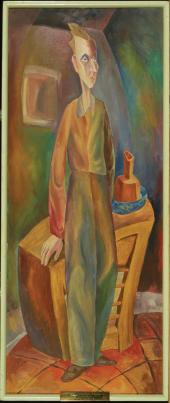
The establishment of the Saskatchewan Arts Board by Order-in-Council in 1948 and the Arts Board Act in 1949 signified a major development for the arts in Saskatchewan and North America. Outside the United Kingdom, where the British Arts Council had just been established, the Arts Board was the first of many: a public arts agency operating and granting funds “at arm's length” from government. The creation of the Arts Board was one of several cultural initiatives undertaken by the government of T.C. Douglas. As part of a larger program of building a public infrastructure to enable individual growth and self-realization, it was based on the Premier's belief that “the people of the Prairies are hungry … for things of the mind and the spirit: good music, literature, paintings and folk songs. This was why the Arts Board was established.”
In 1948 there was little professional arts activity in the province, and many organizations operated without staff. The Arts Board rapidly launched a number of programs to make the arts available to the people of Saskatchewan and to stimulate artistic growth. Several high-profile initiatives engaged the community and caught the attention of the media - particularly outreach programs and tours aimed at smaller towns and villages, workshops to improve artistic standards, and programs to raise public awareness. By 1968, the Arts Board had a unique Permanent Collection, the School of the Arts at Fort San, and consulting services and grant programs which became the agency's signature functions.
In the early 1970s, the government made two decisions which had a profound effect on the Board's future: first, the province created the Department of Culture and Youth in 1972; and then in 1974 it established the provincial lottery system, a portion of the profits from which were dedicated to culture. This system strengthened groups dedicated to community participation and arts education, as well as service organizations such as the Saskatchewan Writers Guild. However, it posed an ongoing challenge to the development of a unified policy and leadership for the arts in the province. It contributed to the ongoing and sometimes heated debate about “professional and amateur” in the arts; and, as lottery revenues increased rapidly, challenged the government to provide increased support to the Arts Board.
The cultural landscape has changed enormously since 1948, in no small measure due to the Arts Board. The Board's early decision to concentrate on raising artistic standards has resulted in an ever-expanding number of practicing artists and arts organizations worthy of public support. With the availability of lottery money for activity that had formerly been its responsibility, the Arts Board entered in the mid-1970s a phase characterized by much greater attention to the growing needs of practicing artists and arts organizations. This strategy responded to the shift in the arts in Saskatchewan, but it resulted in the Board loosening its ties to organizations and activities that had previously occupied a large portion of its time. It also fostered a perception that the Board had lost interest in its development and community-based mandate - a perception that the Board began to address as it went into its fifth decade. This shift and its impact substantially influenced the third phase of the Board's history, from 1990 to the present: the restoration of the Arts Board as the province's single arts agency, with a unified focus for provincial arts policy and funding. In 1990, this idea found full voice as the key recommendation of the provincial government's Arts Strategy Task Force; but it remains only a vision at present. The Task Force Report led to the proclamation of a new Act in 1998, which emphasized a broader application of its powers and responsibilities, particularly in the areas of arts and education, cultural industries, and Aboriginal arts. The latter area had been previously addressed by the Board, but it was not until the late 1990s that formal steps were taken to meet the needs and aspirations of Aboriginal artists. The new Act also spoke to the concept of peer assessment and community input into the development of the Board's operating policies and programs.
In 2004, moving toward its 60th anniversary, the Board directed support to 99 artists, 45 organizations, and 47 projects for a total of over $5.3 million. Recipients of its grants constitute a who's who of Saskatchewan artists. The opportunities for the arts in Saskatchewan and for the Board are many: an ever-expanding community of artists; global markets for Saskatchewan artists; new technologies; and the changing demographics of Saskatchewan. Its mission statement, fashioned in 2000, commits the Board to cultivating an environment where the arts will thrive for the benefit of everyone in Saskatchewan, a task that allows it to respond to emerging needs and opportunities while keeping faith with those who brought the Board into existence and nurtured its early years.
Jeremy Morgan
Print EntryHOME | BROWSE BY SUBJECT | ENTRY LIST (A-Z) | IMAGE INDEX | CONTRIBUTOR INDEX | ABOUT THE ENCYCLOPEDIA | SPONSORS TERMS OF USE | COPYRIGHT © 2006 CANADIAN PLAINS RESEARCH CENTER, UNIVERSITY OF REGINA | POWERED BY MERCURY CMS |
|||
| This web site was produced with financial assistance provided by Western Economic Diversification Canada and the Government of Saskatchewan. |
|||
 |
 |
 |
 |
| Ce site Web a été conçu grâce à l'aide financière de Diversification de l'économie de l'Ouest Canada et le gouvernement de la Saskatchewan. |
|||